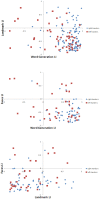Cerebral asymmetries: complementary and independent processes
- PMID: 20300635
- PMCID: PMC2837380
- DOI: 10.1371/journal.pone.0009682
Cerebral asymmetries: complementary and independent processes
Abstract
Most people are right-handed and left-cerebrally dominant for speech, leading historically to the general notion of left-hemispheric dominance, and more recently to genetic models proposing a single lateralizing gene. This hypothetical gene can account for higher incidence of right-handers in those with left cerebral dominance for speech. It remains unclear how this dominance relates to the right-cerebral dominance for some nonverbal functions such as spatial or emotional processing. Here we use functional magnetic resonance imaging with a sample of 155 subjects to measure asymmetrical activation induced by speech production in the frontal lobes, by face processing in the temporal lobes, and by spatial processing in the parietal lobes. Left-frontal, right-temporal, and right-parietal dominance were all intercorrelated, suggesting that right-cerebral biases may be at least in part complementary to the left-hemispheric dominance for language. However, handedness and parietal asymmetry for spatial processing were uncorrelated, implying independent lateralizing processes, one producing a leftward bias most closely associated with handedness, and the other a rightward bias most closely associated with spatial attention.
Conflict of interest statement
Figures


References
-
- Broca P. Remarques sur le siège de la faculté de la parole articulée, suivies d'une observation d'aphémie (perte de parole). Bull Soc Anat (Paris) 1861;36:330–357.
-
- Annett M. Psychology Press; 2002. Handedness and Brain Asymmetry.
-
- McManus C. Weidenfeld & Nicolson; 2002. Right Hand, Left Hand.
-
- Corballis M C. Oxford University Press; 1993. The Lopsided Ape.
-
- Karnath H-O, Ferber S, Himmelbach M. Spatial awareness is a function of the temporal not the posterior parietal lobe. Nature. 2001;411:950–953. - PubMed
Publication types
MeSH terms
LinkOut - more resources
Full Text Sources

